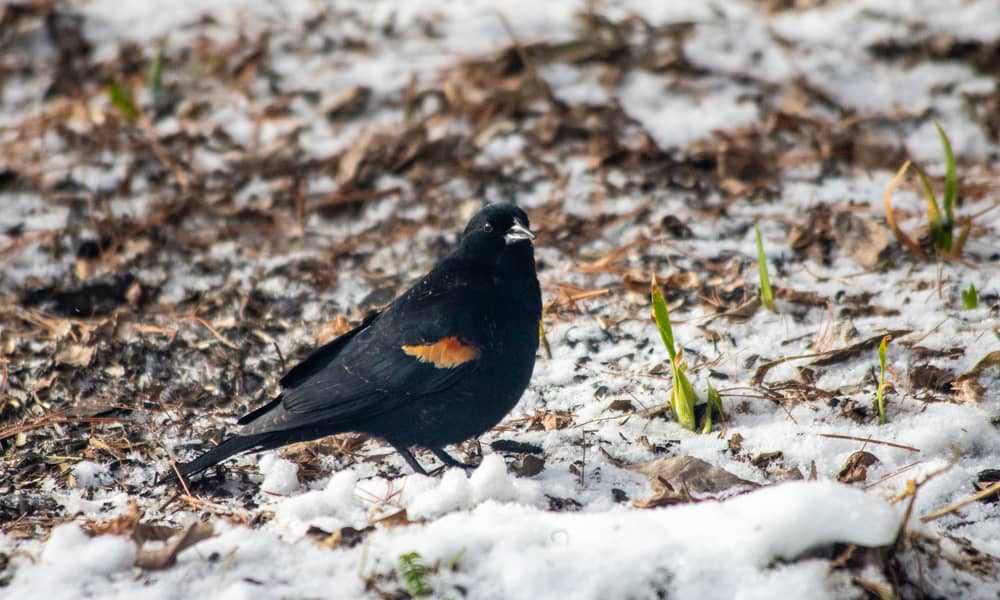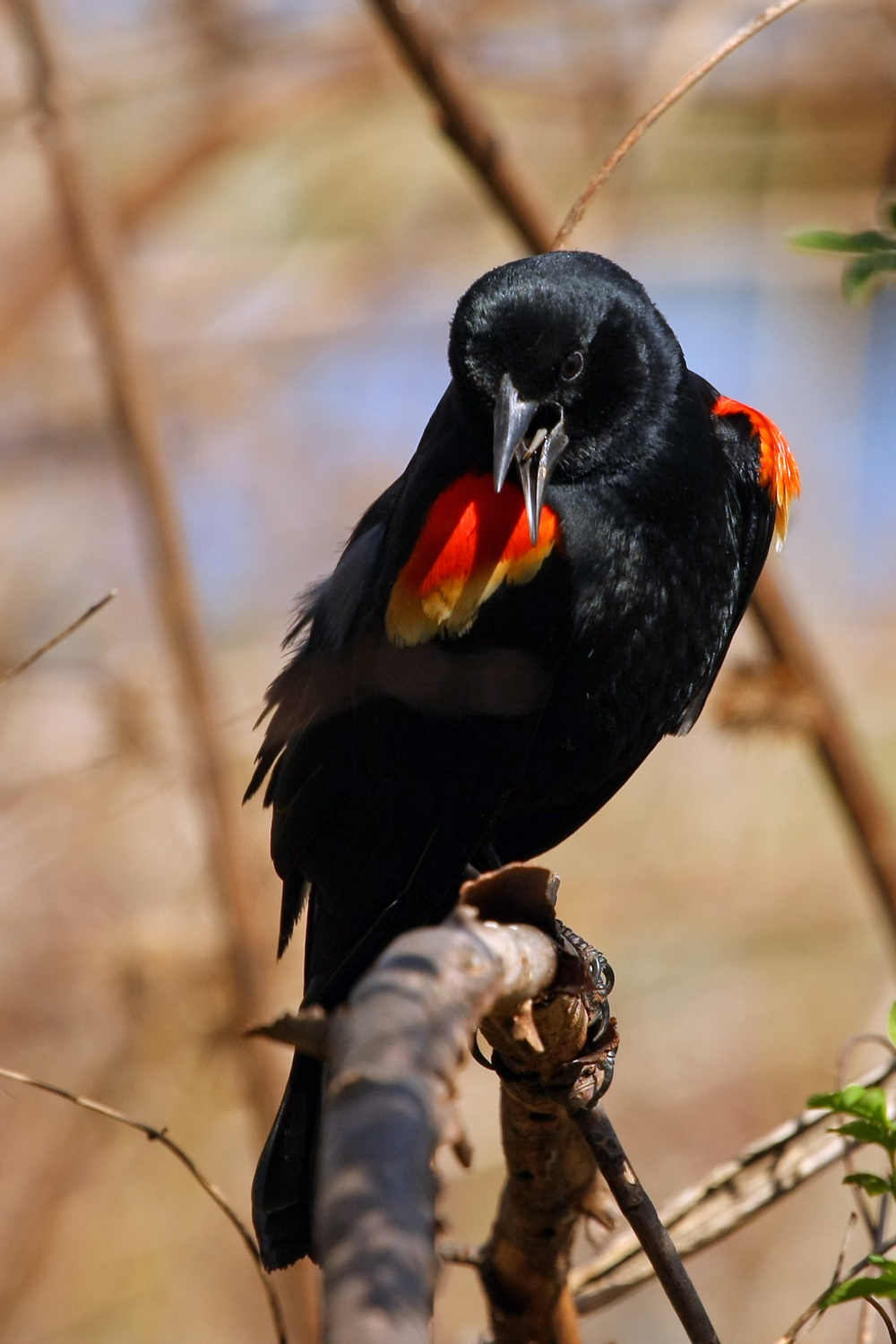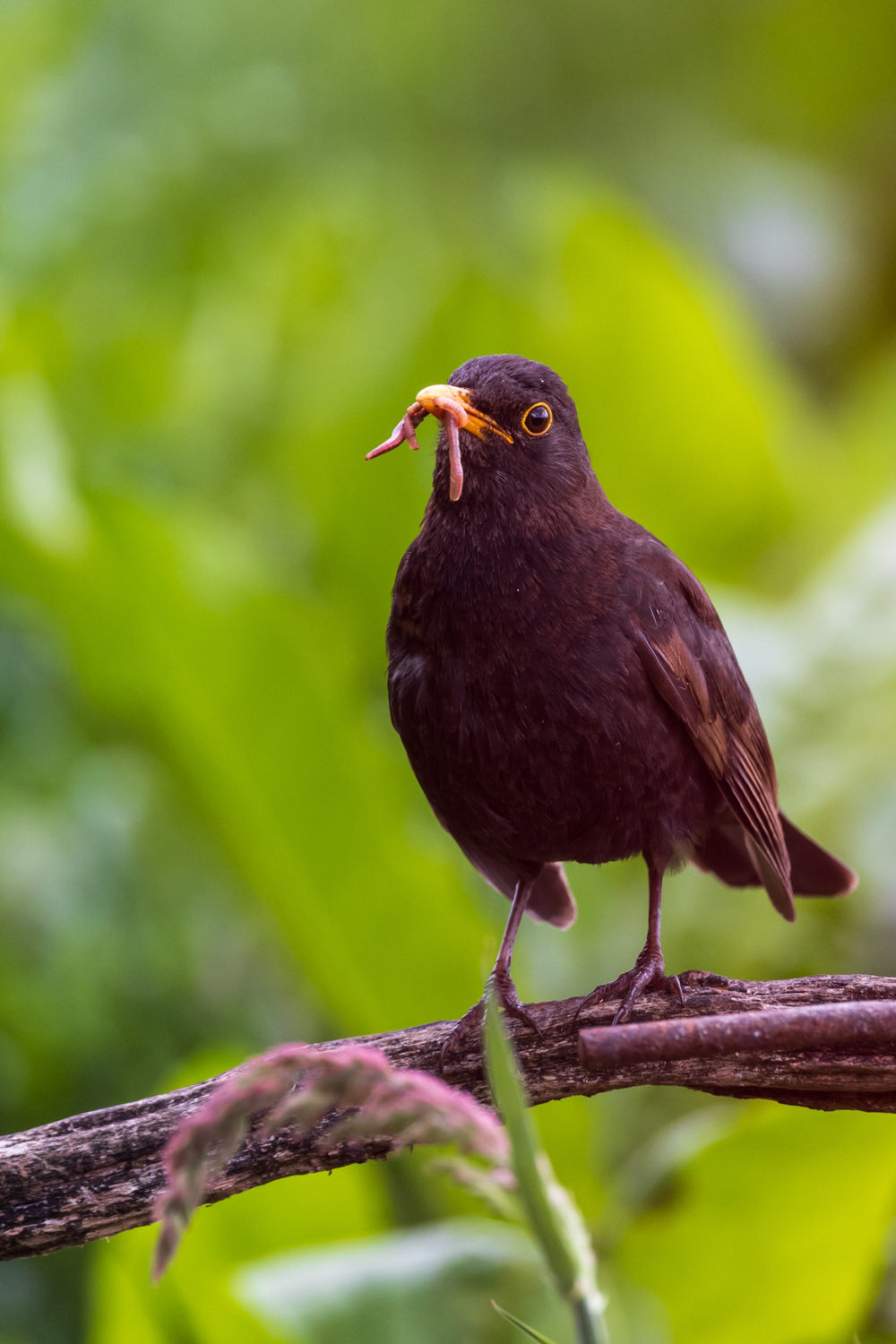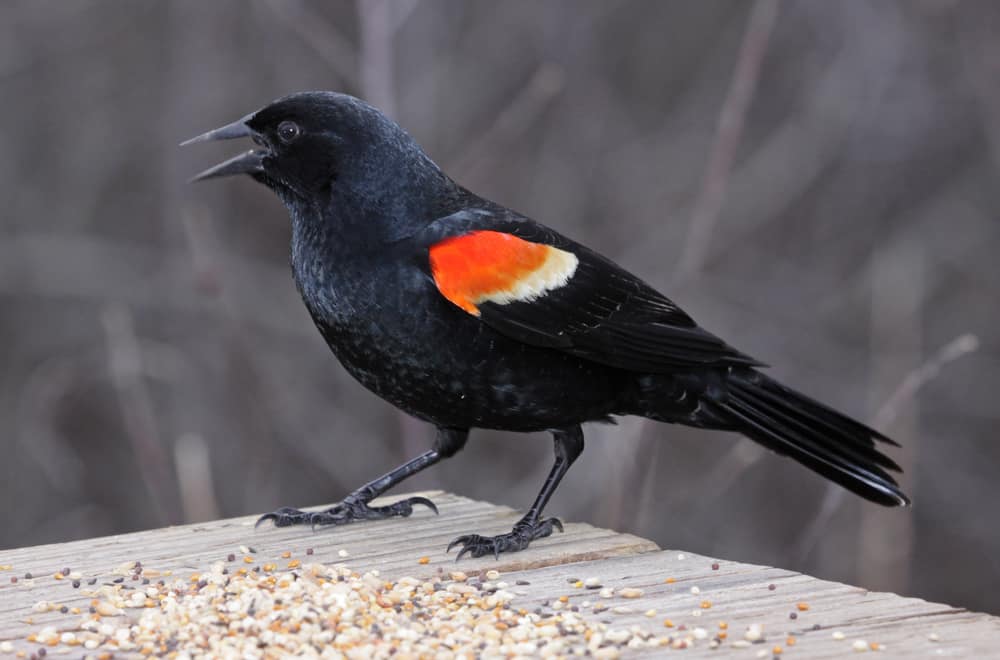Bird enthusiasts often ask themselves, what do red-winged blackbirds eat? This species is common in North and Central America, and there is a good chance you’ve seen it while spending time in nature. Experts believe there are more than 250 red-winged birds in the wild.
Red-Winged Blackbird habits and biology
As you can presume, these birds got their name based on a distinctive pattern on their wings. Red patches can only be seen in males and are especially noticeable when the bird is flying. If we’re talking about a younger blackbird, its spots will be noticeably smaller compared to adults. They will also have a milder orange color.
Like most other species, females are much smaller. In fact, they can be more than 50% lighter than their male counterparts (41.5 grams compared to 64 grams). For example, the smallest female birds can have 29 grams compared to the biggest males reaching 82 grams.
The most important role of these markings is to chase away rivals. Males use their wings (and spots) to instill fear in other red-winged blackbirds but also other bird species. Interestingly enough, the spots are not that important for attracting the opposite sex. Even when their wings were dyed, they still managed to attract females and mate with them. So, they are not that important for reproduction.
Here are some of the most common habits and fun facts:
- These animals are very polygamous. A male can have up to 15 females on his territory. Each one of them will have its own separate nest.
- During the mating season, males tend to fight fiercely with each other. The size of spots plays a crucial role in fending predators and rivals. Birds with smaller spots tend to be attacked much more often.
- It is common for red-winged blackbirds to travel more than 50 miles to their feeding and roosting sites.
- In the wild, a red-winged bird approximately lives for 2 years. However, the oldest bird of this species has managed to reach 15 years and 9 months.
- The bird’s scientific name is Agelaius phoenicus. It is Greek for red and flocking.
What do red-winged blackbirds eat in the wild?
Insects are the primary food for these animals. During the summer and spring, they will focus on ants and smaller bugs. They will scour for seeds and various grains such as corn and wheat when the winter comes around. With their sleek bills, the birds will go into the water and fetch aquatic plants.
Overall, their diet is very diverse. In most cases, they will around or hop on the ground trying to pick up anything they can find. Their main source of nutrients will vary a bit depending on where they live.
Here is a list of their most common foods:
- Beetles
- Grasshoppers
- Caterpillars
- Snails
- Seeds
- Grain
- Nuts
- Worms
- Eggs
- Carrion
- Spiders
- Fledgling birds
- Frogs
Besides being a heavy insectivore, the animal does shy from any type of food. Their diet is full of worms and beetles, but also things such as snails and spiders. Given that the species is so resourceful, it isn’t uncommon for red-winged blackbirds to consume fledgling birds, frogs, eggs, and carrion.
These birds benefit from various types of nutrients. There is very little they can’t digest except for species that we otherwise consider toxic. While they need a lot of proteins, red-winged blackbirds also depend on vitamins, fats, minerals, and carbohydrates. If an adult bird wants to remain healthy, it will eat a lot of different food throughout the season. In that sense, they are very similar to humans.
Red-winged blackbirds require fats and carbohydrates for energy. They are highly dependable on proteins as they allow them to build and maintain healthy levels of enzymes, regenerate tissues, and affect other parts of the body.
Amino acids high in nitrogen are especially important for them. In order to have a healthy reproductive system, the animal needs high levels of this mineral. Nitrogen is also crucial for the development of young chicks. As a result, they are especially dependent on protein-rich foods when they’re young and before breeding.
In terms of minerals, the animal is also very similar to humans. Besides nitrogen, it needs a lot of calcium that would allow it to hatch healthy eggs. They also need a lot of vitamin C, which they secrete through the liver, kidneys, or both organs. Often, the bird eats food according to its personal preferences. As they try different plant and animal species, they will learn more about how they taste and whether they’re edible.
19 Facts about red-winged blackbird
Here are some of the most interesting facts about this species:
- There is a major difference in what red-winged blackbird males eat in comparison to females. While females tend to eat much more weed and weed seeds, males usually focus on waste corn.
- Red-wing blackbirds always try to match other birds when it comes to food quantity. Even if they’re full, they will continue eating for as long as their companions continue to do so.
- Young red-wings eat a lot of different things, but they are also very cautious. Before trying new food, they will check if other birds from the flock are eating it.
- Marsh wrens are natural enemies of red-winged blackbirds. Besides the fact that they attack each other constantly, they will also consume each other’s eggs.
- When it’s breeding season, the species will focus on protein-rich food. They will eat a lot of insects like beetles, butterflies, dragonflies, moths, and damselflies. As they don’t need as many nutrients during winter, they will transition to weed and seeds.
- The animal relies on a feeding method that zoologists refer to as gaping. When hunting insects and other small species hiding under rocks and leaves, the bird will forcibly open these objects with their bills to get food.
- The mating season is a very dynamic period for all male blackbirds. During this time, a male will spend approximately one-quarter of their time fending off both predators as well as other males.
- The birds are very aggressive when defending their territory, and there were reports of attacks on humans.
- During winter, the bird will form great roosts. Experts claim there could be up to million birds in one place during the night. Then, when daylight comes around, they will disperse and start hunting for food.
- Red-winged blackbirds sometimes travel up to 50 miles searching for food.
- Although they have a lot of natural enemies, they are generally socializing well with other blackbird species. During winter, you can see grackles, European starlings, brown-headed cowbirds, and red-winged blackbirds all in one roost.
- Males prepare the mating ground before females migrate to the region. Male animals fly back north during the spring before the females. When it’s time to migrate south, during the fall, they will do so after females.
- The nest-building process occurs in four stages. Female red-wings start by weaving supporting pieces from the surrounding vegetation. They create nest walls around these supports. Then, the cup is lined with mud. The animal uses grass and various herbs to create a layer around the nest during the last step.
- Due to their voracity, some people categorize this species as pests. When they’re in a large flock, the birds tend to ravage large farmyards. They can do significant damage to rice, corn, and sunflower crops. To control them, some farmers install security measures. Unfortunately, these protective systems are now the leading cause of mortality among the species.
- Like many other bird species, red-winged blackbirds share parental duties. However, females do significantly more. After 10 to 14 days of hatching, a young bird will leave the nest.
- Male birds have a similar strategy for both attracting mates and defending territory. They will stand on a high stalk while spreading tail and fluffing feathers. They spread the wings so that the red marking is visible to everyone, and they start singing.
- The animals can be very problematic in large groups. Besides ravaging fields, they often group up on larger predators. The species has various enemies, including raptors, skunks, foxes, snakes, raccoons, and weasels.
- Predators commonly attack young chicks. Animals also pray on blackbirds’ eggs. To avoid these attacks, the animal creates nests in dense foliage and above water. In most cases, the nest is placed 1 to 2 meters above the ground.
- The nests are also well camouflaged. Females have brown feathers allowing them to meld into their surroundings.
Summary
Red-winged blackbirds are very territorial animals that stand out from other birds with their polygamous nature. The animal can be very aggressive, and it is prepared to fight for its territory until the very end.
The bird eats all sorts of food, mostly grains, seeds, and weeds. They also hunt insects and smaller animals. When in larger numbers, red-winged blackbirds can pose a major threat to any farmland. Unfortunately, more and more farmers are installing safety measures against these birds, thus affecting their numbers in the wild.




There is a male red-wing blackbird that comes to visit me several times a day. He sits on my great g rd anddaughter’s plastic playhouse and looks in the window calling or singing until I appear at the window and talk to him. If I sit on the back deck, he comes right on over even if our chicken is out. I have several pictures. He doesn’t come throughout the winter but comes back every spring.